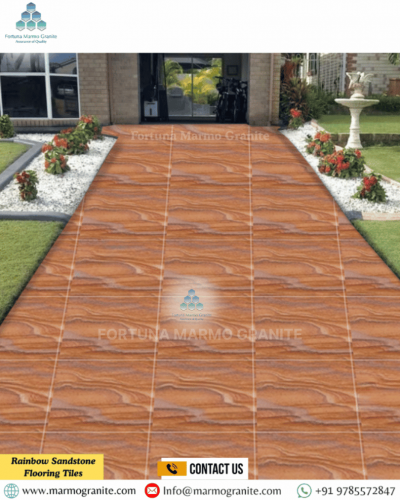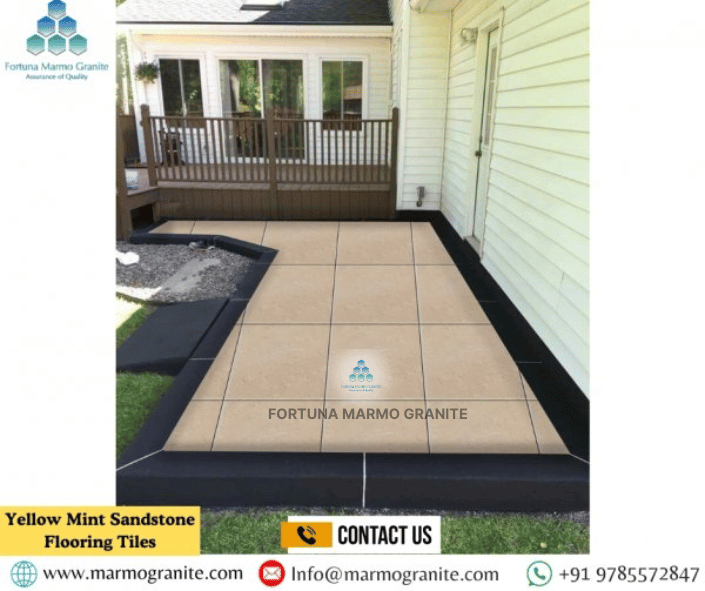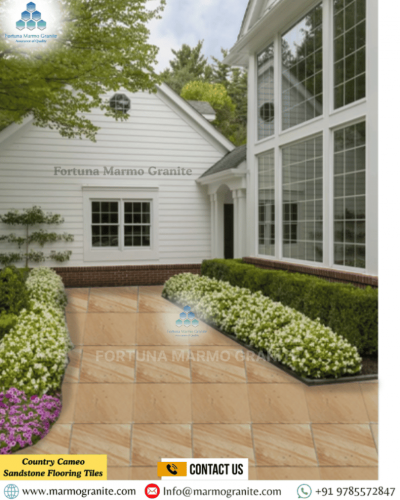Non-Toxic Sandstone for Green Homes: Safe Surfaces, Sustainable Style
Non-Toxic Sandstone for Green Homes Revered for its natural beauty and durability, sandstone has long been a cornerstone of architectural design. With the growing focus on sustainable living and healthier indoor environments, non-toxic sandstone has become a preferred choice for eco-conscious homeowners and builders.
Unlike synthetic or chemically treated materials, sandstone naturally contains no harmful substances or volatile organic compounds (VOCs). This makes it a safe and responsible option for both interior and exterior applications. Its natural porosity allows the stone to "breathe," reducing trapped moisture and preventing mold formation—key factors for maintaining indoor air quality.
Sandstone also excels in sustainability. It requires minimal processing compared to manufactured alternatives, lowering its environmental footprint. When responsibly sourced from quarries that follow ethical and eco-friendly practices, sandstone becomes an even more compelling choice for green homes.
Beyond its functional benefits, non-toxic sandstone offers timeless elegance. Its rich palette of earthy tones and textures complements a variety of design styles, from rustic charm to modern minimalism. It works beautifully for flooring, wall cladding, garden pathways, and even countertops. For those embracing sustainable living, non-toxic sandstone is more than a building material—it is a statement of environmental stewardship, wellness, and enduring beauty.
Non-Toxic Sandstone for Green Homes: Safe Surfaces, Sustainable Style
The concept of a "green home" has moved from niche interest to mainstream aspiration. As awareness of environmental impact and health hazards in conventional building materials grows, demand for sustainable, non-toxic alternatives is rising.
Sandstone, a timeless natural material, is experiencing a resurgence. Its enduring beauty combines with non-toxic properties and remarkable sustainability. Quarrying sandstone requires no harmful chemical treatments, making it a healthier choice for indoor spaces where air quality matters most.
Sandstone naturally regulates indoor temperatures, resists moisture buildup, and ages gracefully without deterioration. When responsibly sourced and expertly crafted, it reduces the construction carbon footprint while enhancing a home's aesthetic with warm textures and earthy tones.
The Rise of the Green Home: More Than Just Energy Efficiency
A green home is often envisioned as a structure adorned with solar panels and bristling with energy-efficient appliances. While these elements are crucial, the true essence of a green home extends far beyond energy consumption. It encompasses a holistic approach to building and living that prioritizes:
- Minimizing environmental impact: This includes sourcing materials responsibly, reducing waste, and conserving natural resources.
- Promoting occupant health: Ensuring indoor air quality is paramount, avoiding materials that off-gas harmful volatile organic compounds (VOCs) or contain toxic chemicals.
- Durability and longevity: Building homes that last reduces the need for frequent renovations and replacements, minimizing their lifecycle environmental footprint.
- Aesthetic appeal and comfort: A green home should be a joy to live in, fostering a sense of well-being and connection with nature.
Understanding "Non-Toxic": What Does it Mean for Building Materials?
The term "non-toxic" in the context of building materials signifies that the product does not release harmful chemicals or substances into the indoor environment that could adversely affect human health. Many conventional building materials, from paints and adhesives to flooring and insulation, can off-gas VOCs, formaldehyde, heavy metals, and other carcinogens or irritants. These can lead to a range of health issues, including respiratory problems, allergies, headaches, and even more severe long-term illnesses.
Non-toxic sandstone, by its very nature, avoids these pitfalls. As a naturally occurring sedimentary rock, it is typically composed primarily of quartz grains, feldspar, and other mineral fragments. When sourced responsibly and processed without the addition of synthetic binders, sealants, or dyes, it remains inert and benign.
Sandstone's Natural Purity: A Foundation of Health
No VOCs: Natural sandstone does not emit volatile organic compounds. Unlike many paints, sealants, and flooring materials, it avoids continuously off-gassing harmful chemicals that can reduce indoor air quality.
Free from Formaldehyde: Formaldehyde, a known carcinogen, often appears in composite wood products and some insulation. Sandstone contains none of it.
No Heavy Metals: Natural sandstone is free from dangerous metals such as lead or mercury, unlike some synthetic materials or treated wood.
Naturally Hypoallergenic: Its inert composition makes sandstone ideal for people with allergies or sensitivities. It does not harbor allergens or release irritants.
Sustainable Style: Sandstone's Environmental Credentials
Abundant and Naturally Occurring: Sandstone is one of the most common sedimentary rocks on Earth, making it widely available. Responsible quarrying ensures extraction does not deplete resources or cause irreversible environmental harm.
Low Embodied Energy: Embodied energy measures the total energy used in extraction, processing, transportation, and installation. Compared to manufactured materials like concrete or steel, sandstone requires much less energy, especially when sourced locally.
Durability and Longevity: Sandstone is exceptionally durable. Structures built from it centuries ago still stand today. Its long lifespan reduces the need for replacement, lowering waste and minimizing the environmental impact of producing new materials.
Thermal Mass Benefits: Sandstone has excellent thermal mass. It absorbs, stores, and slowly releases heat, supporting passive heating and cooling. This reduces reliance on artificial heating and air conditioning, lowering energy consumption.
Recyclability and Reusability: At the end of its long life cycle, sandstone can be crushed and reused as aggregate or repurposed for new applications. This minimizes landfill waste and supports a circular economy.
Biodiversity Protection (with Responsible Sourcing): Reputable quarries follow strict environmental regulations. They often run land rehabilitation programs after extraction, restoring natural landscapes and minimizing disruption to local ecosystems and biodiversity.
Applications of Non-Toxic Sandstone in Green Homes: Where Safe Meets Stylish
- Flooring: Sandstone flooring provides a cool, natural surface that is durable and easy to maintain. Its natural color and texture variations add warmth and character to any space. Being non-toxic, it is an ideal choice for homes with children or pets.
- Wall Cladding and Feature Walls: Sandstone cladding works beautifully for exterior facades or interior accent walls. It offers thermal and acoustic insulation while bringing timeless sophistication and a natural aesthetic indoors.
- Countertops and Vanities: Sandstone can be used for countertops and vanity tops when sealed properly with non-toxic, food-safe sealants. It provides a unique, earthy alternative to engineered stone.
- Fireplaces: Its heat-resistant properties make sandstone perfect for fireplace surrounds. It adds a rustic yet elegant focal point to living spaces.
- Landscaping and Outdoor Spaces: Sandstone is ideal for patios, pathways, retaining walls, and garden features. Its permeability helps with water drainage while blending seamlessly with the natural environment.
- Architectural Features: Sandstone can be sculpted into columns, archways, or intricate carvings. These features enhance the unique character and elegance of a green home.
Conclusion
In conclusion, The use of non-toxic sandstone in green homes represents a thoughtful convergence of health, sustainability, and timeless style. As modern homeowners and builders increasingly prioritize eco-conscious choices, the demand for natural building materials that are both safe and environmentally responsible continues to grow. Yet, Non-toxic sandstone fits seamlessly into this vision—it is a naturally occurring stone that requires minimal chemical processing, contains no volatile organic compounds (VOCs), and promotes healthier indoor air quality. Beyond its health benefits, this sandstone offers a warm, organic aesthetic that harmonizes beautifully with both contemporary and traditional architectural styles.
Moreover, Its durability, low maintenance needs, and recyclability further add to its eco-friendly appeal, making it a truly sustainable solution for green construction. Indian Granite Supplier At Fortuna Marmo Granite, we are deeply committed to supporting environmentally responsible building practices by offering a wide selection of high-quality, non-toxic sandstone that meets global standards. In addition, Our careful sourcing, expert craftsmanship, and dedication to customer satisfaction ensure that you not only receive a beautiful product, but also contribute positively to the environment. Whether you're designing a new home or renovating an existing one, choosing Fortuna Marmo Granite's non-toxic sandstone is a smart investment in style, safety, and sustainability that stands the test of time.




